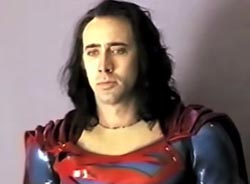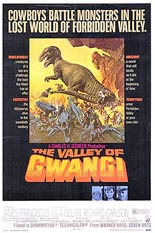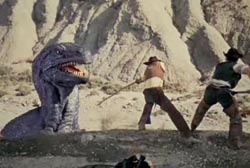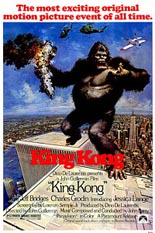
 Toasts Charles Grodin’s sniveling corporate villain in the opening scene of 1976’s King Kong, “Well … here’s to the big one!” While he’s referring to his hunt for untapped petroleum on an Indonesian island, the comment winks at an audience fully aware that a big ol’ angry ape awaits. Personally, I can’t help but take Grodin’s line as a reference to the movie itself: a Dino De Laurentiis production as giant-sized as its cryptozoological star; a spare-no-expense spectacle that bridged the gap between Jaws and Star Wars; and, lest we forget, a once-sacrilegious remake of the 1933 all-time classic — not just for the fantasy-adventure genre, but the art form of cinema as a whole.
Toasts Charles Grodin’s sniveling corporate villain in the opening scene of 1976’s King Kong, “Well … here’s to the big one!” While he’s referring to his hunt for untapped petroleum on an Indonesian island, the comment winks at an audience fully aware that a big ol’ angry ape awaits. Personally, I can’t help but take Grodin’s line as a reference to the movie itself: a Dino De Laurentiis production as giant-sized as its cryptozoological star; a spare-no-expense spectacle that bridged the gap between Jaws and Star Wars; and, lest we forget, a once-sacrilegious remake of the 1933 all-time classic — not just for the fantasy-adventure genre, but the art form of cinema as a whole.
Do-gooder hippie Jack Prescott (Jeff Bridges, Iron Man) stows away in the ship carrying Petrox exec Wilson (Grodin, Midnight Run) and crew. Unlike Wilson, Prescott is not there for the oil; as a professor in Princeton’s Department of Primate Paleontology — try fitting that on a business card — Prescott has in his heart the best interest of the rumored gargantuan gorilla worshipped by the primitive islanders. En route to the isle, the Petrox vessel picks up something else for Prescott’s heart: the lifeboat-stranded, would-be actress named Dwan (Jessica Lange, Tootsie) — not Dawn, but Dwan, and she is dmub as drit.
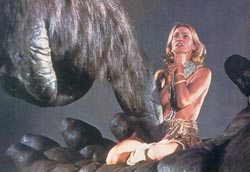 Her eventual presence on the island catapults Kong into a horny tizzy; I can relate. Other than the climax’s change of venue from the ESB to the WTC, the largest difference this bicentennial Kong has over its Depression-era forefather is the cranked-up kinkiness! The ’33 Kong may have sniffed his fingers after handling his distressed damsel, but this ape intends at hitting a homer, starting with stripping Dwan from the confines of that clingy evening gown of hers. Although unnatural and imbalanced, their chemistry is a welcome sign o’ the times; when Kong saves Dwan from a giant snake … well, let’s just say the symbolism is not lost — in fact, it’s as clear as Crystal Pepsi.
Her eventual presence on the island catapults Kong into a horny tizzy; I can relate. Other than the climax’s change of venue from the ESB to the WTC, the largest difference this bicentennial Kong has over its Depression-era forefather is the cranked-up kinkiness! The ’33 Kong may have sniffed his fingers after handling his distressed damsel, but this ape intends at hitting a homer, starting with stripping Dwan from the confines of that clingy evening gown of hers. Although unnatural and imbalanced, their chemistry is a welcome sign o’ the times; when Kong saves Dwan from a giant snake … well, let’s just say the symbolism is not lost — in fact, it’s as clear as Crystal Pepsi.
Time has been both kind and unkind to director John Guillermin’s Towering Inferno follow-up. To deal with the “unkind” part firstly and quickly, its Oscar-winning (!) effects by E.T.’s Carlo Rambaldi play beyond hokey by today’s standards, heightening the comedy not intended by Guillermin or screenwriter Lorenzo Semple Jr. (who re-teamed for the 1984 stinker Sheena: Queen of the Jungle). On the coin’s flip side, Lange’s performance now registers as one. This being her film debut, she played an IQ-challenged, dim-bulb bimbo of enormous naiveté so well, audiences and critics confused the character with the actress. We have come to know better.
The approach taken to the source material by Guillermin is admirably workmanlike and unassuming, in that he doesn’t allow his direction to get in the way of — or distract from — the action. (It’s still uncertain if he possessed an authorial stamp at all.) His shots do not call attention to themselves, with the exception of the POV of a NYC subway car as it careens toward Kong’s greedy grasp. The biggest complaint we can throw the pic’s way is that at two hours and 14 minutes, it could be considered slow … until you compare it to the 3.35-hour slog of Peter Jackson’s oversized 2005 remake, whereupon Guillermin’s trip to camp looks duly efficient. Even without Jackson’s version retroactively propping up Guillermin’s, this second King Kong remains a good time. —Rod Lott
Get it at Amazon.
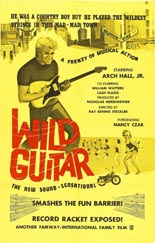
 In Wild Guitar, Arch Hall Jr. is Bud Eagle, a hopeful musician from Fuckstink, Texas, who takes off for Hollywood with (literally) 15 cents in pursuit of his big break. As with any such case, Bud becomes an overnight sensation in about an hour.
In Wild Guitar, Arch Hall Jr. is Bud Eagle, a hopeful musician from Fuckstink, Texas, who takes off for Hollywood with (literally) 15 cents in pursuit of his big break. As with any such case, Bud becomes an overnight sensation in about an hour. 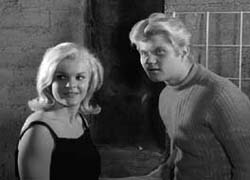 But I have to say, this is a very well-made movie. There’s some zingy dialogue, some beautifully shot photography and a biting, cynical view of the music industry (especially for 1962). And Arch Hall Jr., dare I say, is actually pretty good.
But I have to say, this is a very well-made movie. There’s some zingy dialogue, some beautifully shot photography and a biting, cynical view of the music industry (especially for 1962). And Arch Hall Jr., dare I say, is actually pretty good. 

 From 2013,
From 2013, 

 Toasts Charles Grodin’s sniveling corporate villain in the opening scene of 1976’s
Toasts Charles Grodin’s sniveling corporate villain in the opening scene of 1976’s 
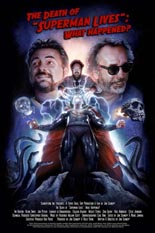
 Although the book world has chronicled the
Although the book world has chronicled the 